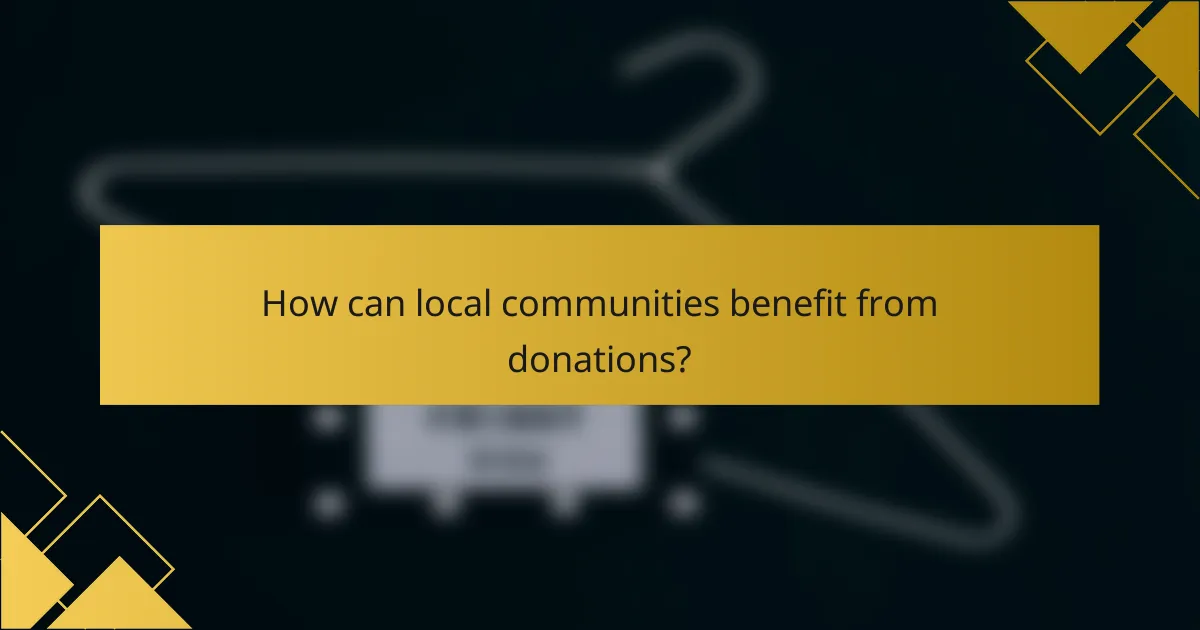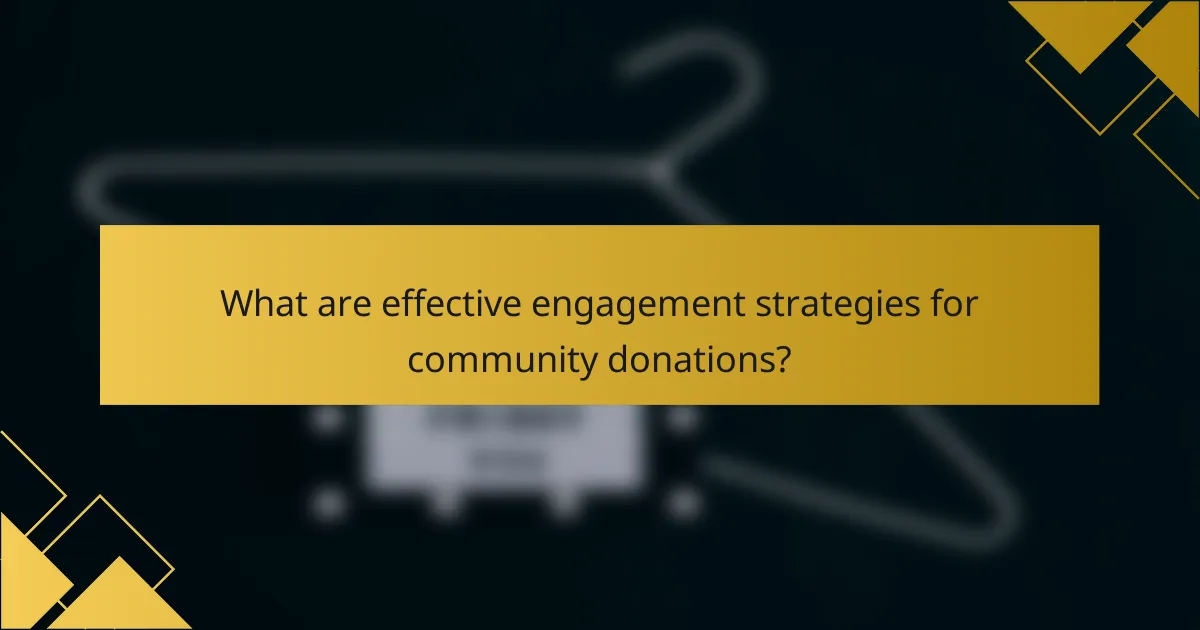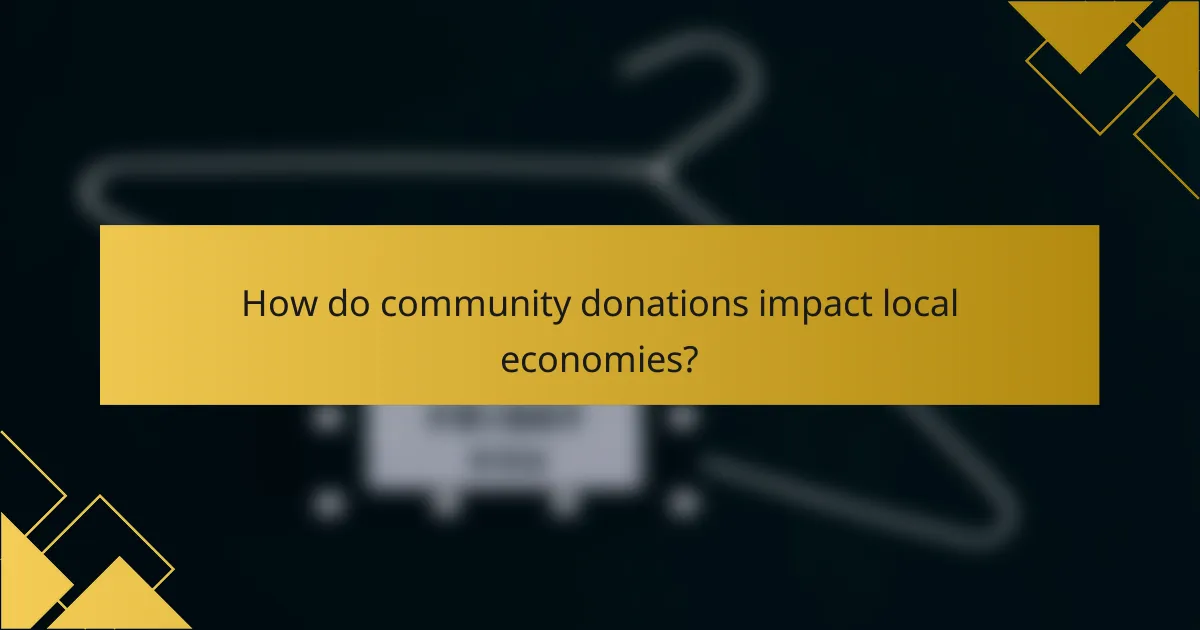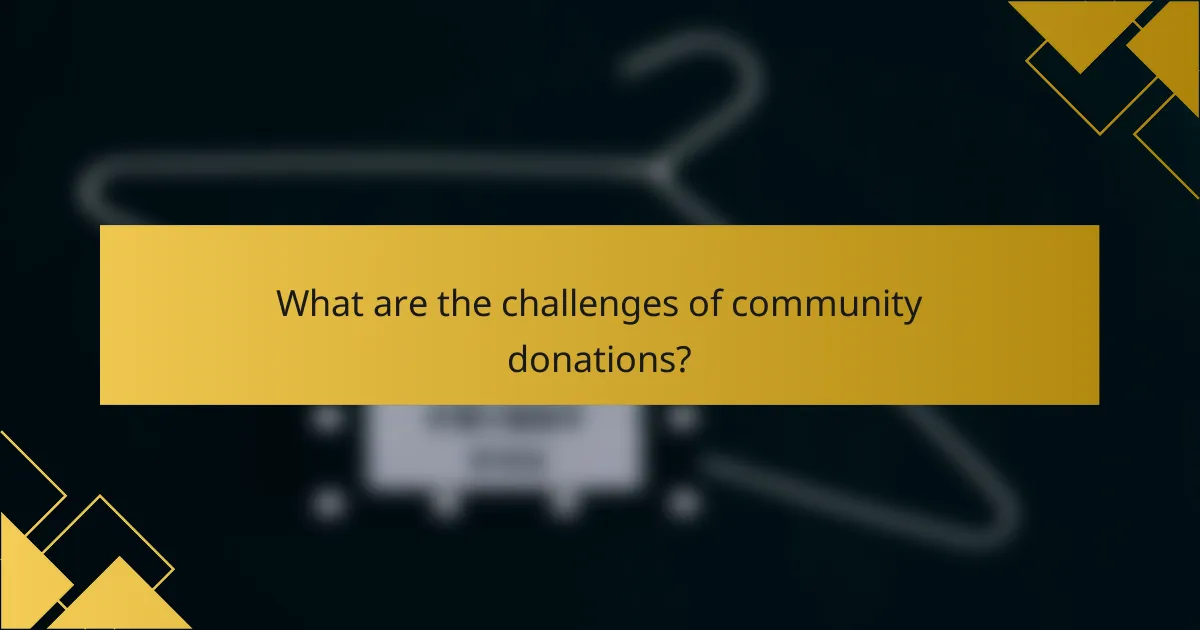Community donations play a vital role in enhancing local services and supporting nonprofits, ultimately improving residents’ quality of life. By implementing effective engagement strategies, communities can connect with potential donors, fostering relationships and encouraging participation in local initiatives. These contributions not only provide essential funding but also stimulate local economies, leading to job creation and increased resilience.

How can local communities benefit from donations?
Local communities can significantly benefit from donations by enhancing services, supporting nonprofits, and facilitating development projects. These contributions foster engagement and resilience, ultimately improving the quality of life for residents.
Improved local services
Donations can lead to enhanced local services such as education, healthcare, and infrastructure. For instance, funds may be allocated to upgrade community centers, provide better educational resources, or improve public transportation.
Communities can prioritize which services need funding based on local needs assessments. Engaging residents in this process ensures that donations are directed toward the most impactful areas.
Support for local nonprofits
Local nonprofits play a crucial role in addressing community needs, and donations can provide them with the necessary resources to operate effectively. These funds can help nonprofits expand their programs, hire staff, or purchase essential supplies.
Engaging with local nonprofits through donations not only supports their missions but also strengthens community ties. Residents can participate in fundraising events or volunteer opportunities to further enhance these organizations’ impact.
Community development projects
Donations can fund community development projects that improve public spaces and promote social cohesion. Examples include parks, community gardens, and recreational facilities that encourage residents to connect and engage with one another.
When planning these projects, it’s beneficial to involve community members in the decision-making process. This ensures that the projects reflect the desires and needs of the residents, leading to higher participation and satisfaction.
Emergency relief efforts
In times of crisis, donations can provide immediate support for emergency relief efforts, such as natural disasters or public health emergencies. These funds can be used for food, shelter, medical supplies, and other critical resources.
Communities should establish clear channels for collecting and distributing donations during emergencies. Collaborating with local organizations can streamline efforts and ensure that aid reaches those in need quickly and efficiently.

What are effective engagement strategies for community donations?
Effective engagement strategies for community donations involve leveraging various platforms and activities to connect with potential donors. These strategies should focus on building relationships, raising awareness, and encouraging participation in local initiatives.
Social media campaigns
Social media campaigns are a powerful way to engage the community in donation efforts. Platforms like Facebook, Instagram, and Twitter allow organizations to share stories, updates, and calls to action, reaching a broad audience quickly. Utilizing eye-catching visuals and compelling narratives can significantly increase engagement.
Consider creating specific hashtags to track donations and encourage sharing. Regularly updating followers on progress and showcasing the impact of their contributions can foster a sense of community and motivate further support.
Community events and fundraisers
Hosting community events and fundraisers can create a personal connection between donors and the cause. Events such as charity runs, bake sales, or local concerts not only raise funds but also build community spirit. Engaging activities can attract diverse participants and encourage them to contribute.
Ensure events are well-promoted through local media and social channels. Offering incentives, such as raffle prizes or recognition for top donors, can enhance participation and increase overall donations.
Partnerships with local businesses
Forming partnerships with local businesses can amplify community donation efforts. Businesses can provide sponsorships, host donation drives, or match employee contributions, which can significantly boost fundraising totals. Collaborating with well-known local brands can also lend credibility and attract more donors.
When approaching businesses, highlight the mutual benefits, such as increased foot traffic and positive community relations. Consider creating a recognition program for participating businesses to encourage ongoing support and engagement.

How do community donations impact local economies?
Community donations significantly bolster local economies by providing essential funding for various initiatives and services. These contributions can lead to job creation, increased local spending, and enhanced resilience within the community.
Job creation
Community donations often fund local projects and organizations, which can create new job opportunities. For instance, a donation to a local nonprofit may allow it to hire additional staff or expand its services, directly impacting employment rates in the area.
Moreover, when local businesses receive donations, they may use these funds to hire more employees or invest in training programs, further stimulating job growth. This cycle of funding and employment can lead to a more robust local job market.
Increased local spending
When community donations are directed toward local businesses or initiatives, they encourage increased spending within the area. For example, a community fundraiser for a local event can attract visitors who spend money at nearby shops and restaurants, boosting the local economy.
Additionally, as organizations receive donations, they often reinvest those funds into the community, creating a multiplier effect. This means that every dollar donated can lead to several dollars in local economic activity, benefiting various sectors.
Enhanced community resilience
Community donations play a crucial role in building resilience by supporting local services that respond to crises. For example, donations to food banks or shelters can help ensure that essential services remain available during emergencies, such as natural disasters or economic downturns.
Furthermore, a strong culture of giving fosters a sense of community and solidarity, which can enhance collective problem-solving and resource-sharing. This interconnectedness helps communities adapt and thrive in the face of challenges, ultimately leading to a more stable local economy.

What criteria should be considered for selecting donation recipients?
When selecting donation recipients, it’s crucial to evaluate their transparency, alignment with community needs, and track record of impact. These criteria ensure that donations are used effectively and reach those who need them most.
Transparency and accountability
Transparency and accountability are essential for building trust with donors and the community. Organizations should openly share how funds are allocated and the outcomes of their initiatives. Look for recipients that provide regular financial reports and updates on their projects.
Consider organizations that are registered with relevant regulatory bodies, as they often adhere to higher standards of accountability. For example, in the United States, nonprofits are required to file Form 990, which details their financial activities.
Alignment with community needs
Donation recipients should align with the specific needs of the community they serve. Conducting surveys or community meetings can help identify pressing issues and ensure that donations address these effectively. For instance, if a community is facing food insecurity, supporting local food banks may be a priority.
Engaging with community leaders and stakeholders can provide insights into the most impactful areas for support. This alignment not only maximizes the effectiveness of donations but also fosters community engagement and ownership of the initiatives.
Track record of impact
Evaluating the track record of potential donation recipients is vital to understanding their effectiveness. Look for organizations that can demonstrate measurable outcomes from previous projects, such as the number of individuals served or improvements in community well-being.
Consider using metrics like the percentage of funds that directly support programs versus administrative costs. A good benchmark is that at least 75% of donations should go directly to program services. This ensures that the majority of contributions are making a tangible difference.

What are the challenges of community donations?
Community donations face several challenges that can hinder their effectiveness and sustainability. Key issues include resource allocation problems and donor fatigue, which can impact both the availability of aid and the willingness of individuals to contribute.
Resource allocation issues
Resource allocation issues arise when donations are not distributed effectively among community needs. Organizations may struggle to prioritize which projects or areas require funding, leading to imbalances where some initiatives receive ample support while others are neglected.
To address this, it is essential for community groups to conduct thorough needs assessments and engage with local stakeholders. This ensures that donations are directed where they can have the most significant impact, whether that be food security, education, or healthcare.
Donor fatigue
Donor fatigue occurs when individuals become overwhelmed by frequent requests for contributions, leading to decreased willingness to donate. This can be particularly pronounced in communities that face ongoing crises or where fundraising efforts are constant.
To mitigate donor fatigue, organizations should vary their outreach strategies and focus on building long-term relationships with contributors. Highlighting the tangible impacts of donations and providing regular updates can help maintain donor engagement and encourage continued support.










